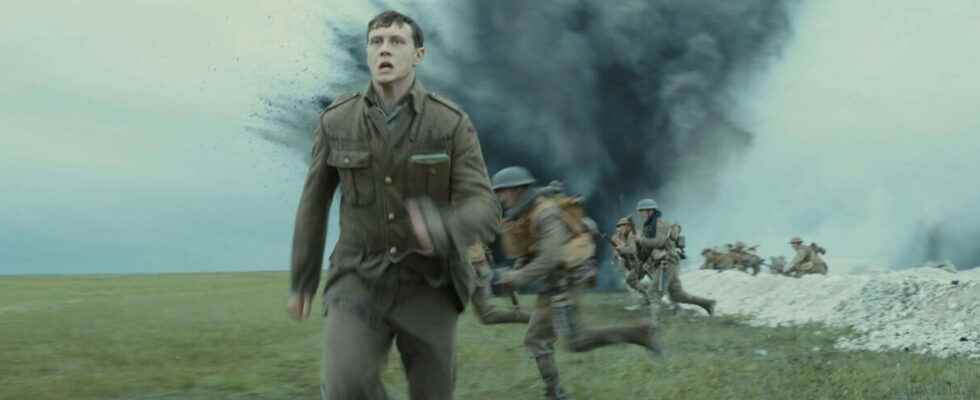1917 MOVIE. Sam Mendes’ film, 1917, gives the impression of having been shot in a single take, thanks to an ingenious sequence shot. The director explained how he did it.
[Mis à jour le 13 novembre 2022 à 20h40] 1917 allowed Sam Mendes to take up a sacred challenge: to immerse the spectator in full First World War, with the impression of living it in real time. Watching this film released on January 15, 2020 and broadcast on the TV program on TF1 this Sunday, November 13, 2022 gives the impression of being made up of a single “sequence shot” (a shot that does not stop). For 1 hour 50 minutes, the public is therefore totally on the side of the two British soldiers who must transmit a message behind enemy lines, to avoid the death of thousands of men. “For me, this film had to happen in real time in order to follow the journey of these soldiers as closely as possible,” says Sam Mendes in a making-of video.
Complicated to shoot, 1917 is nevertheless what is called a “false sequence shot”. It is not a single sequence shot that makes up the film, but several long scenes put end to end, giving the impression of never being cut thanks to editing strings and technical virtuosity. In total, around 40 to 50 scenes were shot for the needs of this war film, estimates Sam Mendes in the columns of Première. This process has already been used in other films before, such as La Corde by Alfred Hitchcock or more recently Birdman by Alejandro González Iñárritu. However, the exercise was particularly complicated for 1917: not only was this sequence shot a shooting challenge, but this choice also implied that the film was completely pre-edited: “In general, in films, we use tricks, we can always shorten or cut a scene. There, it is impossible”, comments Sam Mendes, always in the making-of.
Learn more
1917 film synopsis – While the First World War is in full swing, two young soldiers must carry a message to the Second Battalion. If they fail, the troop will be taken in a trap from which 1600 men will not escape. Schofield and Blake have one day to infiltrate behind enemy lines and avoid the deaths of their brothers in arms. An impossible mission on which the survival of Blake’s brother depends…
1917 seems to have conquered the critics when it was released in cinemas on January 15, 2020: the French media are seduced by the latest feature film by Sam Mendes. “A total film” for Cinemateaser, “virtuoso” and “exciting” for Elle, “brilliant and captivating” for La Voix du Nord, the critics are generally rave reviews: Sam Mendes’ crazy bet is a success, just like this real- fake immersive sequence shot. In its review, Le Figaro points out that “the connections are invisible and, in addition to the technical prowess, this bias creates a spectacular and threatening immersion. The crossing of no man’s land, a landscape of desolation and death, is one of the most strong evocations of the butchery of 14-18 that we have seen for a long time”. Télérama admits, “the director of Skyfall is particularly inspired” with this feature film. A few negative echoes emerge however, such as Première, whose editorial staff is divided over this new work: one of the journalists affirms that “Mendes has a sense of the great playful spectacle”, while another deplores a “device which runs on empty, and systematically gives the impression of working for its own publicity”. Same observation at Liberation, which affirms that “Sam Mendes replays the Great War in an immersive show and without point of view”. What seems certain is that 1917 should satisfy on the one hand the war movieson the other, lovers of spectacular scenes.
Have you seen 1917? Give your opinion on Linternaute.com
The 1917 making-of tells us more about how the film was staged. Roger Deakins, legendary cinematographer had to deal with this crazy challenge. The film takes place almost entirely outdoors and, since the characters move around all the time, no set is the same, which was difficult to manage in terms of lighting. “Filming outdoors makes us dependent on the light and the weather and we realized we couldn’t light” because the cameras sometimes moved so much that it was impossible to place lights outside the field. We also had to pay attention to the mismatches caused by the clouds! Below, discover the making-of video which allows us to discover how the teams of 1917 took up this impressive cinematographic bet.
“1917 – “Sequence Shot” Featurette”
1917 accumulated no less than ten nominations for the 2020 Oscars: it was cited in the categories best film, best director, best original screenplay, best cinematography, best original music, best sound (mixing and editing), best hairstyles and makeup and best special effects. . However, the ultra-favorite film only won three statuettes: best special effects, best cinematography and best sound mixing. On January 5, 2020, Sam Mendes’ war film won the Golden Globe for Best Dramatic Film and Best Director.
